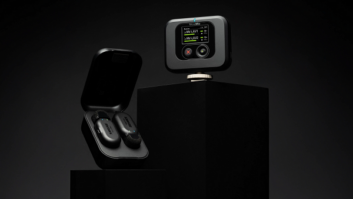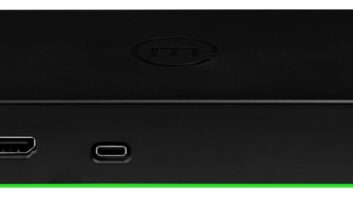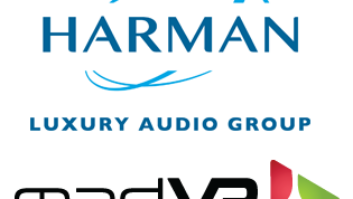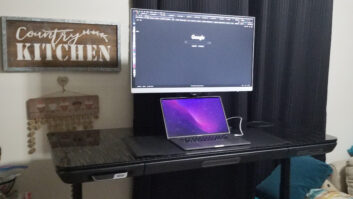Santa
Ana, Calif.
– SRS Labs plans to market an SRS-branded TV-audio processor said to eliminate abrupt
and annoying changes in perceived volume levels when TV channels are changed or
loud TV commercials interrupt a broadcast.
The company’s MyVolume processor, which consumers insert between
a TV and cable/satellite set-top box, will be available in time for Christmas in
two active versions, both small enough to fit in the palm of a hand. One version
connects to HDMI cables running between a set-top box and a TV. It will cost no
more than $200. The second device will connect via audio RCA cables and will be
much less expensive, the company said without getting specific.
SRS is also talking
to other suppliers to bring MyVolume devices to market under their own brands.
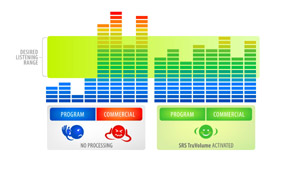
The company’s MyVolume processor joins one other SRS-branded CE device on the market, a
sound-enhancing iWow accessory that consumers plug into an iPod to enhance
sound performance. The company also sells sound-enhancing PC software to
consumers.
For the most part, however, the supplier of audio post-processing
technologies has focused on licensing its intellectual property to makers of
TVs, PCs, A/V receivers (AVRs) and other consumer devices. The technologies
include multiple virtual-surround technologies and SRS
Circle Surround II, which up-converts two-channel and matrix-surround sources
to 6.1-channel surround.
SRS also licenses
TruVolume volume-leveling technology, which is incorporated in MyVolume and is
built into a handful of TVs from Vizio, Samsung and Best Buy under its Insignia
brand. The technology also appears in a powered Vizio sound bar. SRS is also marketing TruVolume to makers of AV
receivers, portable media players, PCs, cellphones and OEM autosound systems.
Though TruSurround can be built into TVs, set-top boxes, surround
bars and AVRs, SRS chose to
introduce a standalone MyVolume processor to reach the large number of
consumers who use legacy set-top boxes, aren’t in the market for another TV, and
don’t connect their TVs to AVRs or sound bars, said chief technology officer
Alan Kraemer. The first set-top box with TruVolume, however, could be available
late this year or early next, and some set-top boxes now in consumers’ homes
could be upgraded with TruVolume software downloaded by the cable or satellite
operators, he noted.
For these consumers and for MyVolume purchasers, the SRS technology will eliminate the annoyances caused
by cable and satellite content providers that deliver audio content at
different levels from one another, Kraemer said. Commercial tend to be much
louder than a TV program to catch viewers’ attention, he added. These volume
fluctuations force consumers to continually adjust volume, but with MyVolume, consumers
set a preferred volume level only once, he explained.
MyVolume and TruVolume also help level out volume differences
that occur within a program when cheers, for example, erupt during a sports
event, but the technology is implemented less aggressively in these
circumstances to “preserve some of the program’s original dynamics,” Kraemer
said.
Compared to competing volume-leveling technologies, Kraemer
claimed, TruVolume keeps volume levels much more consistent while “completely
eliminating” such audible side effects as the pumping of a soundtrack’s background
noise, such as rain, during pauses in dialog. SRS
found “a new way to analyze the noise content of a signal to determine if it’s
something you want to hear,” he said.
Other sound-leveling technologies in the CE market are not as
aggressive in maintaining consistent volume levels, Kraemer contended, because
if they did, they would produce audible artifacts.
Like other digital noise-leveling technologies, TruSurround constantly
monitors and adjusts the audio signal, and it concentrates on leveling the
volume of mid-band frequencies because human ears are more sensitive to those
frequencies. TruVolume analyzes 20 frequency bands “and takes the appropriate
action, which is less aggressive in some bands,” Kraemer said.
The HDMI version of My Volume will pass on only the two-channel
PCM output of a set-top box, not a Dolby Digital 5.1 bitstream. SRS chose to do that because set-top boxes default
to two-channel PCM over HDMI, although consumers can go into the set-top’s menu
to transfer Dolby Digital over HDMI, Kraemer explained. Many TVs won’t
recognize a Dolby Digital signal via their HDMI inputs, and many that do will
emit clicking and popping sounds, he continued.








